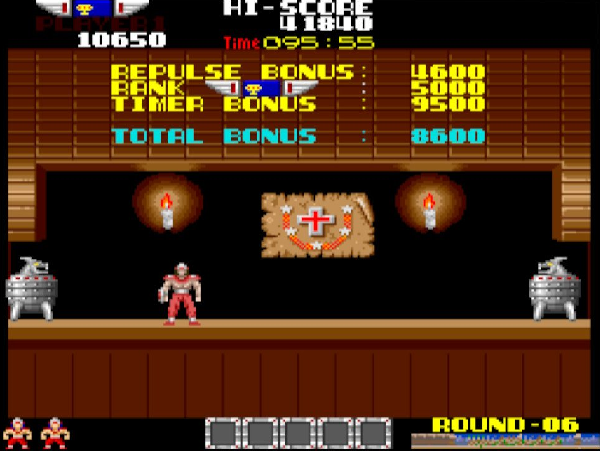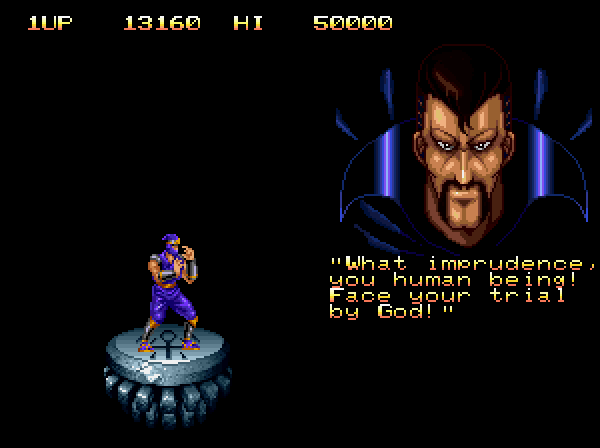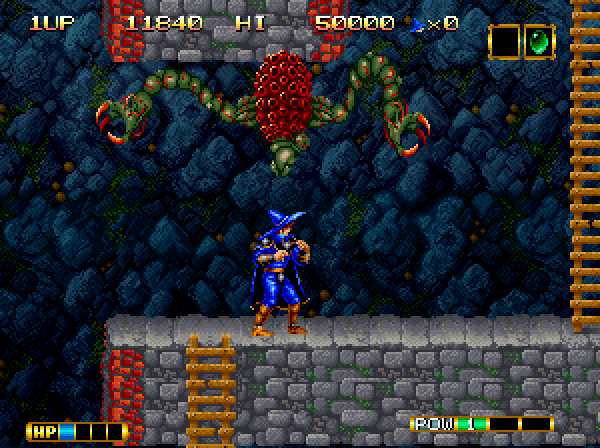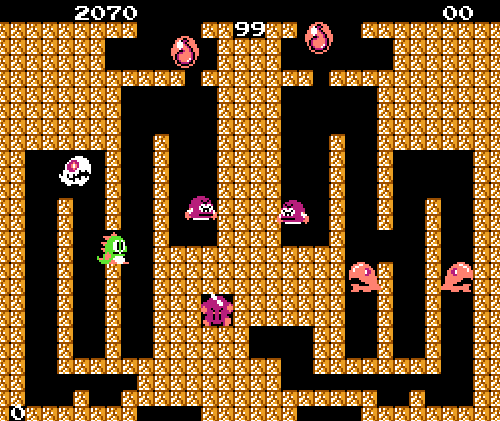Games weren’t always so forgiving. Any sensibly designed arcade draw of the 1980s or 1990s had to keep players moving and, preferably, dying and paying for another go. A timer, often situated next to your score, was just as much an enemy as a robot dinosaur or leering street punk. Console games often adopted this idea without question, and even an pleasant stroll through Super Mario Bros. 3 would be deadly if the timer ran down.
Many games were content to unceremoniously kill player’s avatar when an on-screen timer ran out, but others went beyond that. It wasn’t enough that time elapsed; it also summoned a monster, invincible and relentless, to slay you and remind you that merciless game design waits for no one.
RYGAR’S MIST MONSTER
The original Rygar has a limited following, to put it charitably. It’s very much a typical arcade side-scroller from 1986: repetitive, punishing, and stingy in its payoff. Today it’s remembered mostly for inspiring a largely different and much more interesting NES version.
Rygar‘s first outing is intriguing only in those small, strange details that popped up in 1980s arcade games. Developers often tossed in whatever random sights they wanted, creating an atmosphere vaguely tantalizing in its random and limited decor. Rygar has hints of that in its odd introductory text that mentions 4.5 billions years of “dominators,” in its unexplained lion-man end boss, and in the way each level ends with symbols ranging from idols to crosses. It’s all likely just chosen for effect, but it feels like it should mean something, as though Rygar was secretly bankrolled by a bizarre cult.

Another effective touch appears when players let the timer tick down to nothing. An intense strain takes over the soundtrack, and then THIS shows up.

An angry mist-demon floats across the screen, and it’s impossible to slay unless Rygar reaches the level’s end. It’s probably the most imposing sight in the game; most of the creatures are only slightly larger than Rygar himself, but this giant cloud of temporal fury is an unexpected horror, even if it now looks like something from a cartoon about the evils of pollution.
Both the NES Rygar and the PlayStation 2 revamp have much more inventive monsters, and both are much better games. But they’re rarely as abrupt in their surprises as that hellish miasma.
MAGICIAN LORD’S BRAIN BEAST
It’s only halfway fair to call Magician Lord a showcase game. It was the nearest thing the Neo Geo had to a defining launch title, so it shows off the console’s affinity for large sprites, rich music, and elegant dialogue.

Yet there’s so much more to Magician Lord. In their extravagant fervor, developer ADK stacked this side-scroller with every sort of monster and oddity imaginable. Sorcerer hero Elta’s journey starts off in ruins where even the background statues are weird, and things lead to a giant digestive tract, a half-decomposed dragon, a hellhound with spikes for eyes, and a constant stream of new and nasty little creatures.
And what if you try to survive by staying in one spot? It’s tempting, since there’s no timer visible. Yet there’s one working behind the scenes, and you’d best not dawdle. If you hang around a level for too long, Magician Lord sends periodic enemies to spit cunningly aimed projectiles at Elta, but these aren’t too hard to repel. The real spectacle comes when that unseen timer hits zero.

An enormous and invincible creature floats down and follows Elta until he finish the stage or it murders him. It’s one of the weirder enemies in the game, resembling a seed pod or a massive cerebellum with tentacles, and the fact that it’s completely silent makes it all the more creepy.
There’s no dramatic music to warn of its arrival, no gooey sounds from its waving limbs. It just looms like some bulbous, squamous, eldritch Langolier sent to devour the unmotivated, and it hates you just as much as every other enemy in Magician Lord.
BUBBLE BOBBLE’S BARON VON BLUBBA
Imagine that you’re a child in 1989, enjoying Bubble Bobble on the family NES during one lazy, unsupervised evening. Your precious dinosaur protagonist is hopping through levels and blowing bubbles with ease, but after a few dozen stages you’re facing some frustratingly positioned enemies. So you sit back and size up the situation for a few minutes. Suddenly, the words HURRY UP! flash on the screen, and all of the remaining foes grow red and manic. And that’s not all.

The skull-like Baron Von Blubba appears, bone-white and menacing and yet still kind of cute. There’s no defeating him, as he’s impervious to bubbles and other attacks. He also implies the existence of a Bubble Bobble aristocracy that’s never explored further.
It seems a harmless little measure now, but I’d guess that more than a few young players were driven to panic by the sudden and unheralded sight of Baron Von Blubba. Bubble Bobble is mild in its threats, pitting you against windup robots and gelatinous blobs, and all of a sudden there’s a grinning, red-eyed memento mori dedicated to hunting you down. The game has no on-screen timer, either, so it was up to players to gauge just how far away that HURRY UP! and the Baron might be at any given moment in Bubble Bobble.
Taito’s arcade games employed invincible timekeepers often: flying skulls swarm lingering players in Cadash, and the adorable kiwi hero of The New Zealand Story must contend with a flying, clock-toting devil if he spends too long in any stage. Yet they weren’t as memorable as Baron Von Blubba.
And yes, his name is Skel-Monsta in just about every subsequent Bubble Bobble game. But let’s not lie about which is better.

Hi Todd, I’ve been enjoying this blog since your piece on the Captain Commando comic. I don’t suppose you could help me identify some game artwork? The scanned image is at my Flickr https://www.flickr.com/photos/8847885@N08/5599954005/in/dateposted-public/
ReplyDeleteI cut it out from a hints and tips book from a console magazine in the early 90s.